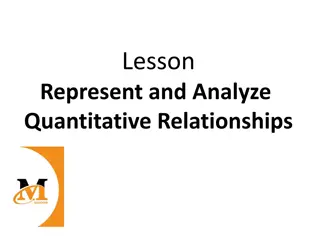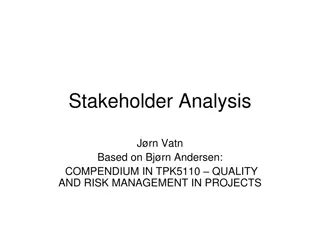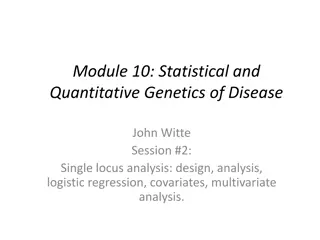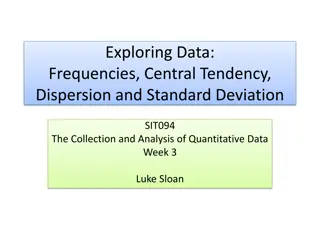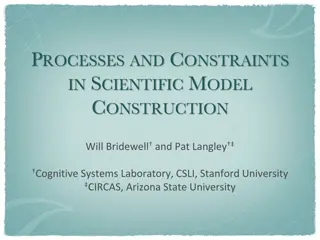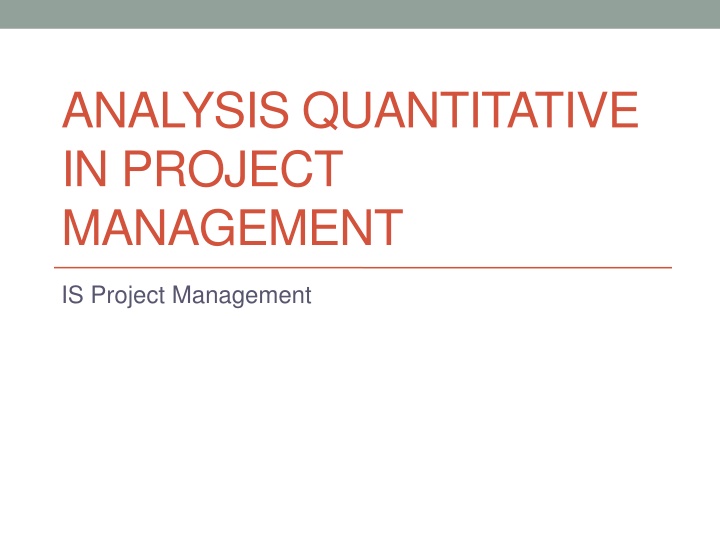
Principles of Effective Cost Estimation in Project Management
Discover the key principles for accurate cost estimation in project management, including dividing projects, including all activities, leveraging past experiences, and accounting for differences in extrapolation. Utilize algorithmic models and systematic approaches to estimate development effort effectively.
Download Presentation

Please find below an Image/Link to download the presentation.
The content on the website is provided AS IS for your information and personal use only. It may not be sold, licensed, or shared on other websites without obtaining consent from the author. If you encounter any issues during the download, it is possible that the publisher has removed the file from their server.
You are allowed to download the files provided on this website for personal or commercial use, subject to the condition that they are used lawfully. All files are the property of their respective owners.
The content on the website is provided AS IS for your information and personal use only. It may not be sold, licensed, or shared on other websites without obtaining consent from the author.
E N D
Presentation Transcript
ANALYSIS QUANTITATIVE IN PROJECT MANAGEMENT IS Project Management
2 Principles of effective cost estimation Principle 1: Divide and conquer. To make a better estimate, you should divide the project up into individual subsystems. Then divide each subsystem further into the activities that will be required to develop it. Next, you make a series of detailed estimates for each individual activity. And sum the results to arrive at the grand total estimate for the project.
3 Principles of effective cost estimation Principle 2: Include all activities when making estimates. The time required for all development activities must be taken into account. Including: Prototyping Design Inspecting Testing Debugging Writing user documentation Deployment.
4 Principles of effective cost estimation Principle 3: Base your estimates on past experience combined with knowledge of the current project. If you are developing a project that has many similarities with a past project: You can expect it to take a similar amount of work. Base your estimates on the personal judgement of your experts or Use algorithmic models developed in the software industry as a whole by analyzing a wide range of projects. They take into account various aspects of a project s size and complexity, and provide formulas to compute anticipated cost.
5 Algorithmic models Allow you to systematically estimate development effort. Based on an estimate of some other factor that you can measure, or that is easier to estimate: The number of use cases The number of distinct requirements The number of classes in the domain model The number of widgets in the prototype user interface An estimate of the number of lines of code
6 Algorithmic models A typical algorithmic model uses a formula like the following: COCOMO: E = a + bNc Functions Points: S = W1F1 + W2F2 +W3F3 +
7 Principles of effective cost estimation Principle 4: Be sure to account for differences when extrapolating from other projects. Different software developers Different development processes and maturity levels Different types of customers and users Different schedule demands Different technology Different technical complexity of the requirements Different domains Different levels of requirement stability
8 Principles of effective cost estimation Principle 5: Anticipate the worst case and plan for contingencies. Develop the most critical use cases first If the project runs into difficulty, then the critical features are more likely to have been completed Make three estimates: Optimistic (O) Imagining a everything going perfectly Likely (L) Allowing for typical things going wrong Pessimistic Accounting for everything that could go wrong
9 Principles of effective cost estimation Principle 6: Combine multiple independent estimates. Use several different techniques and compare the results. If there are discrepancies, analyze your calculations to discover what factors causing the differences. Use the Delphi technique. Several individuals initially make cost estimates in private. They then share their estimates to discover the discrepancies. Each individual repeatedly adjusts his or her estimates until a consensus is reached.
10 Principles of effective cost estimation Principle 7: Revise and refine estimates as work progresses As you add detail. As the requirements change. As the risk management process uncovers problems.
Building Software Engineering Teams Software engineering is a human process. Choosing appropriate people for a team, and assigning roles and responsibilities to the team members, is therefore an important project management skill Software engineering teams can be organized in many different ways a) Egoless b) Chief programmer c) Strict hierarchy
12 Software engineering teams Egoless team: In such a team everybody is equal, and the team works together to achieve a common goal. Decisions are made by consensus. Most suited to difficult projects with many technical challenges.
13 Software engineering teams Hierarchical manager-subordinate structure: Each individual reports to a manager and is responsible for performing the tasks delegated by that manager. Suitable for large projects with a strict schedule where everybody is well-trained and has a well-defined role. However, since everybody is only responsible for their own work, problems may go unnoticed.
14 Software engineering teams Chief programmer team: Midway between egoless and hierarchical. The chief programmer leads and guides the project. He or she consults with, and relies on, individual specialists.
15 Choosing an effective size for a team For a given estimated development effort, in person months, there is an optimal team size. Doubling the size of a team will not halve the development time. Subsystems and teams should be sized such that the total amount of required knowledge and exchange of information is reduced. For a given project or project iteration, the number of people on a team will not be constant. You can not generally add people if you get behind schedule, in the hope of catching up.
16 Skills needed on a team Architect Project manager Configuration management and build specialist User interface specialist Technology specialist Hardware and third-party software specialist User documentation specialist Tester
17 Project Scheduling and Tracking Scheduling is the process of deciding: In what sequence a set of activities will be performed. When they should start and be completed. Tracking is the process of determining how well you are sticking to the cost estimate and schedule.
18 Some Basic Project Management Terminology Deliverable: some concrete thing which is to be delivered, to the client or internally to the development team; e.g. Specifications reports Executable program Source code Task/Activity: something we have to do during the project; e.g. Defining user requirements Coding a module Doing system testing Each task or activity will take some length of time Referred to as duration of task Sometimes measured in days, weeks, etc. Sometimes measured in person-days, person-weeks, etc. Person-day = number of people X number of days Example: 12 person days for writing all code could mean 1 person 12 days or 4 people 3 days Note: not always true that a task that takes 1 programmer 12 days would take 12 programmers 1 day
19 Dependencies and Milestones For a given task or activity, may be impossible to start it without some other task(s) or activity(ies) having been completed; e.g. Cannot start coding without completing design Cannot start system testing without completing code integration and test plan If task B cannot start without A being completed, we say B depends on A There is a dependency between A and B Milestone: some achievement which must be made during the project; e.g. Delivering some deliverable Completing some task Note, delivering a deliverable may be a milestone, but not all milestones are associated with deliverables
20 Setting and Making Deadlines Deadline time by which milestone has to be met Some deadlines are set by the client Others are set by us on project to make sure project stays on track To set a deadline for completing task T, we must consider how long it will take to: Complete the tasks that task T depends on Complete task T itself If we miss a deadline, we say (euphemistically) the deadline has slipped This is virtually inevitable Important tasks for project managers Monitor whether past deadlines have slipped Monitor whether future deadlines are going to slip Allocate or reallocate resources to help make deadlines PERT chart and Gantt charts help project managers do these things (among others)
PERT Charts 21 PERT = Project Evaluation and Review Technique PERT chart = graphical representation of the scheduling of events in a project Sample PERT Chart: 3 B2 C 3 6 E 3 10 13 6 0 4 A 4 13 1 2 F3 4 0 7 10 D 3 4 5 10 7 A PERT chart is a graph Edges are tasks/activities that need to be done Nodes are the events or milestones Task edge T from event node E1 to event node E2 signifies: Until event E1 happens, task T cannot be started Until task T finishes, event E2 cannot happen Events often simply represent completion of tasks associated with arrows entering it
22 PERT Chart Task Edges Parts of a task/activity edge Task letter D 5 Task duration Task letter: Often keyed to a legend to tell which task it represents Task duration = how long (e.g. days, hours) task will take
23 PERT Chart Event Nodes Event Number: Earliest Completion Time (ECT): Sequence number assigned 9 5 Earliest time this event can be achieved, given durations and dependencies 19 Only task edges indicate dependencies Latest Completion Time (LCT): Latest time that this event could be safely achieved
24 Building a PERT Chart Steps: Make a list of all project tasks (and events if possible). Find interrelated task dependencies (what task has to be completed before other tasks) Draw initial PERT without durations, ECTs or LCTs Estimate duration of each task Fill in durations Calculate ECTs and LCTs 1. 2. 3. 4. 5. 6. We will do this for an example system: Generic software system with 3 modules
25 Example: Generic Software Project TASK ID Task Description A Specification B High Level Design C Detailed Design D Code/Test Main module E Code/Test DB module F Code/Test UI module G Write test plan H Integrate/System Test I Write User Manual J Typeset User Manual To start PERT chart: identify dependencies between tasks
26 Dummy Tasks Sometimes it is necessary to use dummy tasks: Shows the dependency between 2 events where no activity is performed Example: Events 3, 4 signify the compilation of separate modules. Create an event 5 to signify all modules compiled together . Denote dummy tasks using dash lines 9 3 10 T 9 5 12 3 9 4 12
27 Example: Tasks with Dependencies To start the PERT, identify the dependencies amongst tasks TASK ID Task Description Preceed ID Succ. ID A Specification 1 2 B High Level Design 2 3 C Detailed Design 3 4 D Code/Test Main 4 5 E Code/Test DB 4 6 F Code/Test UI 4 7 G Write test plan 4 8 Dummy Task 5 8 Dummy Task 6 8 Dummy Task 7 8 H Integrate/System Test 8 9 I Write User Manual 8 10 J Typeset User Manual 10 9
28 Software Example: Skeleton PERT Chart 5 D A B C E H 1 2 3 4 6 8 9 I J F 1 7 G Note: dummy tasks connecting events 5, 6 and 7 to 8
29 Estimating Durations Suggestions for estimating durations of tasks: Don t just make up a number Look at previous similar tasks from other projects and use those as guidelines Try to identify factors such as difficulty, skill level Each weighting factor will help you make a better estimate Factors to consider: Difficulty of task Size of team Experience of team Number, attitude and availability of end users Management commitment Other projects in progress
30 PERT Chart With Durations 5 D 7 A 3 B 2 C 2 E 6 H 5 1 2 3 4 6 8 9 J F I 2 1 3 1 7 G 2 Say we have estimated durations of all tasks (in days) New PERT chart, with durations filled in: Note, dummy tasks (dashed lines) always have a duration of zero
Calculating ECTs ECT = earliest time event can be completed To calculate: For an event not depending on others: ECT = 0 Usually this is the first event For an event E depending on one or more others: Calculate ECTs of event(s) that E depends on Add duration(s) of task(s) leading to E If E depends on more than one event, take MAX Proceed left to right ( ) through the chart Exercise: calculate the ECT for our example. 31
Calculating LCT LCT = latest time event can be completed, while still finishing last ask at indicated time To calculate: For an event which no other events depend on: LCT = ECT Generally there will only be one such event For an event E which one or more others depend on: Calculate LCTs of event(s) that depend on E Subtract duration(s) of task(s) leading from E If more than one event depends on E, take MINIMUM Proceed right to left ( ) through PERT chart Exercise: calculate LCT for our example 32
33 Critical Path Red line is the critical path What does it represent?
Uses of PERT Charts 34 We can use PERT charts for: Determining the estimated time to complete a project Deriving actual project dates Allocating resources Identifying potential and current problems (is one task behind schedule?, can we shuffle people?) Critical Path: Path through chart such that if any deadline slips, the final deadline slips (where all events have ECT = LCT (usually there is only one) In software example: Task I is not on the critical path: even if we don t finish it until time 18, we re still okay Task D is on the critical path: if we don t finish it until for example, time 16, then: We can t start task H (duration 3) until time 16 So we can t complete task H until time 21 We can use PERT charts for Identifying the critical path Reallocating resources, e.g. from non-critical to critical tasks.
35 PERT Chart Exercise Task Prec Tasks Description Time(hrs) A none decide on date for party 1 B A book bouncy castle 1 C A send invitations 4 D C receive replies 7 E D buy toys and balloons 1 F D buy food 3 G E blow up balloons 2 H F make food 1 I H, G decorate 1 J B get bouncy castle 1 K J, I have party 1 L K clean up 4 M K send back bouncy castle 1 N L send thank you letters 3 O M donate unwanted gifts 3
Review Create your daily activities and durations using PERT Find out about COCOMO 1. 2.












